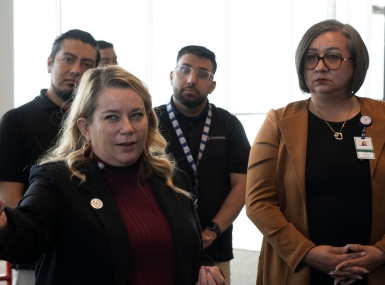Packed town hall brings out many perspectives on opioid epidemic

Four years ago, the heroin and opioid drug epidemic was not on many counties' horizons
If a county has a courthouse, it probably also has an opioid drug problem.
That sobering fact drew a standing-room-only crowd at what was dubbed a town hall discussion on the opioid crisis Feb. 26 during NACo’s Legislative Conference.
“If you’re sitting right now thinking, ‘we don’t have this problem either, it hasn’t touched our community,’ you’re either not paying attention or it’s right next door and it’s about to get to you shortly,” said Russ Hamill, Montgomery County, Md.’s assistant chief of police.
Hamill’s sentiment was shared by other speakers, including Erie County, Pa. Executive Kathy Dahlkemper, who served on the NACo-NLC Joint Opioid Task Force. She heard a familiar refrain while visiting communities.
“As I listened to everyone from across the country, from both cities and counties, almost every single person… said, ‘we are at the epicenter of the opioid epidemic,’” she said.
She, along with county and city elected officials, law enforcement and federal health specialists, presented several perspectives on the crisis that, after brewing for more than a decade among prescription painkiller users, erupted in the last few years as addicts moved to cheaper heroin.
On top of the human toll, counties bear costs in responding to and being proactive about the problem. Richard Jorgensen, coroner in DuPage County, Ill., identified why.
“Every aspect of addiction is paid for by the county,” he said. “You pay for the sheriffs, you pay for the police officers, the jail, the public defender, court system. When you reduce addiction, you reduce those costs to your county.”
Phyllis Randall is the Board chair for Loudoun County, Va., but she also works as a mental health counselor in neighboring Prince William County’s jails, where she has seen the problem change firsthand in recent years.
“Substance abuse therapists haven’t been caught as off-guard as the law enforcement and political community,” she said. “Substance abuse seems to come in five-year cycles. We had crack cocaine, then PCP, then methamphetamine and now opioids. Five years from now will be something else.”
She said a basic treatment model to fight substance abuse would go a long way toward addressing whatever specific effects different drugs have on the brain.
This epidemic has been different, she said, because of how addicts view the drugs.
“With any other addictive substances, if they get a garbage batch of PCP, nobody goes back to that dealer,” she said. “With heroin, they want to get the dope that gets you closest to death as possible.”
According to Hamill, law enforcement in his Washington, D.C. suburb was surprised by the epidemic.
“Four years ago we weren’t seeing this on the horizon,” he said. “We weren’t seeing arrests for opioids, including heroin, we weren’t seeing crimes related to it.”
Now, Montgomery County’s homicide and narcotics units work fatal overdose cases together, treating them as homicides.
Gary Moore, judge executive in Boone County, Ky. has served as a co-chair of the task force, and his advice for counties dealing with the epidemic reflected that cooperation.
“We didn’t talk about cities or counties, we talked about communities,” he said. “Don’t try to do this alone, work collaboratively as a region.”
Huntington, W.Va. Mayor Steve Williams, another task force member, seconded that.
“It doesn’t know geographic boundaries, it doesn’t know political boundaries,” he said.
Williams and Randall both addressed elected officials’ obligation to lead and face the skepticism and anger liable to come from minority communities that suffered through opioid addiction when it was more of a street drug.
“To move forward, we have to take ownership for the sins of the past,” Williams said. “It’s natural to get defensive when someone says ‘where were you back then?” and respond ‘I’m here now!’ You have to acknowledge that ‘yes, I wasn’t there then, but I daggone will be sure that we’re owning it going forward.’”
Randall and Dahlkemper likewise said that the framing of the epidemic and removing stigma would help start addressing the problem.
Families are starting to acknowledge when their children die of overdoses,” she said.
Randall seconded, “If people are ashamed to talk about (addiction), they will never get help.”
Jorgensen, who himself prescribed opioid painkillers as a surgeon, initially drew rebukes from other county officials when he noticed, as coroner, how many people were dying of overdoses.
“Nobody would talk about it,” he said. “I was told I was embarrassing my county by talking about it. Well, embarrassing is a 15-year-old with a needle in her arm, dead.”
Tracking statistics has been difficult, according to Christopher Jones, acting associate deputy assistant secretary, science and data policy at the U.S. Department of Health and Human Services. Though the lag for national-level numbers on overdoses is roughly 12 months, it is down from a previous 18-24-month lag.
But challenges remain in testing and funding.
“Anything we see, heroin deaths, opioid deaths, fentanyl deaths, they’re all underestimates,” he said. “It’s just the floor of the problem.”
On one hand, the number of cases has gone up while budgets for public health offices have gone down, he said, and as drugs are chemically altered, testing for them during autopsies hasn’t caught up.
“Heroin deaths may be down, but in reality fentanyl deaths, or something like it, are up, but we don’t know,” he said. “It’s $300 to test for heroin, $200 more to test for something on top of that; when you have more overdoses it’s really taxing the medical examiners, especially for small counties.”
Attachments
Related News

El Paso County, Texas helps migrants on their way
Though they don't often stay more than a day, asylum seekers receive care and services from El Paso County, Texas before they leave for their next destination.

L.A. County fends off homelessness with an assist from A.I.
A predictive model pulls data from six county departments to create a list of the county’s most vulnerable population — people who frequently show up in the county’s criminal justice and hospital systems and who access benefits like SNAP.

